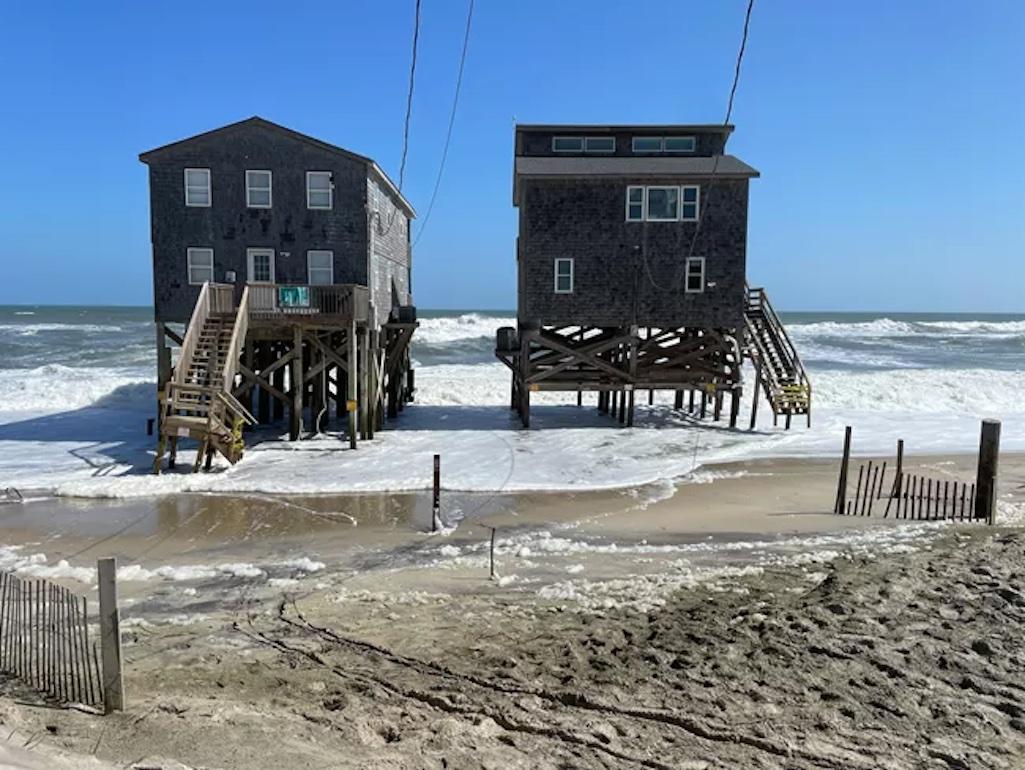
State and local officials have been trying to figure out what to do about the growing number of threatened beachfront houses on North Carolina's Atlantic coast. The problem is there's no designated pool of money to demolish or move the houses. Now the National Park Service is stepping in to help.
Cape Hatteras National Seashore recently bought two houses in danger of collapsing into the ocean at Rodanthe and officials plan to demolish them. They stand alone on the beach, and often are surrounded by water, said Seashore Superintendent Dave Hallac.
This story was reported and written by WUNC
"These are structures that have their pilings standing in the water during most tides and the owners were struggling. They didn't have a good way out," Hallac said during an Oct. 12 meeting of a state task force studying the problem.
The Park Service said this week it paid fair market value for the two houses. Land records show it paid $471,000 for one, a six-bedroom house, and $260,000 for the other, a four-bedroom house. The purchases were completed without taxpayer dollars, thanks to money from The Land and Conservation Fund, which in turn is funded by income from oil and gas leases, according to the Park Service.
The National Seashore is seeking a contractor to remove the structures and restore the public beach, beginning by the end of this month.
The houses were built in 1985 and 1980 at a time when the beach was wider. A May report from the Program for the Study of Developed Shorelines at Western Carolina University says 20 feet of beach per year have been lost in recent years, in part because of more intense storms and sea-level rise. Neither the county nor the town has the money to rebuild the beach. That report recommended buyouts as a solution.
"This is an exciting project because without other tools in the toolbox right now it gives us the opportunity to remove the threat to the public and to the resources," Hallac said at the task force meeting. "It also helps these property owners out that don't have a lot of other options. And finally it allows us … (to) turn that site into a public access site for the public to enjoy and walk on the beach."
Hallac said the Park Service wants to buy other threatened homes. "We're hopeful to scale the program up in the future," he said.
But even as these two houses are removed, others remain under threat. A 2020 study by the Department of Environmental Quality's coastal management division found about 750 beachfront structures, or about 8% of the total, were at risk in North Carolina.
Hallac pointed to a section of Dare County, farther north on the Outer Banks, where beach renourishment projects last year at Avon and Buxton had reduced the threat to Highway 12 and many beachfront structures.
"It is interesting to see in these very fast eroding areas how within one year some of these structures are already essentially threatened again and their pilings are being surrounded by water at certain times," he said.
"So it goes to show you that there's probably not a one-size-fits-all solution, and this work group and the toolbox we'll hopefully recommend and put together helps all of us and coastal communities to advance this issue," Hallac said.
It was the third meeting of the Threatened Oceanfront Structures Interagency Work Group, which includes state and local officials. The DEQ and Cape Hatteras National Seashore organized the work group after at least three houses fell into the ocean in Rodanthe last year, spreading debris for miles.
See more, including a timeline of recent house collapses, on the Cape Hatteras National Seashore web page on Threatened Oceanfront Structures.





